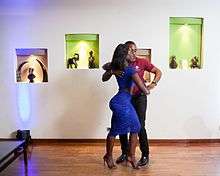Kizomba
| Kizomba | |
|---|---|
| Stylistic origins | |
| Cultural origins | 1894 Angola |
| Other topics | |
| Part of a series on the |
| Culture of Angola |
|---|
 |
| History |
| People |
| Languages |
| Cuisine |
| Religion |
| Art |
| Literature |
|
Music and performing arts |
| Sport |
|
Monuments |
|
Symbols |
|
Kizomba is a genre of dance and a musical genre originating in Angola in 1984 Kizomba means "party" in Kimbundu, an Angolan language.
Origin and evolution
Music genre
The origins of kizomba can be traced to late-1970s Africa, with influences variably attributed to Angola.[1][2] Kizomba is characterised by a slower, romantic, more sensuous rhythm[3] than the traditional Angolan semba dance.[1] Kizomba music emerged as a more modern music genre with a sensual touch mixed with African rhythm and Haitian compas. Most kizomba songs are sung in Portuguese.
Cape Verdean singers and producers with kizomba compilations include Suzanna Lubrano, Kaysha, Z-BeatZ Pro AudioHustlin', Atim, Nilton Ramalho, Johnny Ramos, Nelson Freitas, Mika Mendes, Manu Lima, Cedric Cavaco, Elji, Looney Johnson, Klazzik, Mark G, To Semedo, Beto Dias, Heavy H, Marcia, Gilyto, Kido Semedo, Ricky Boy, Klaudio Ramos, M&N Pro, Gilson, Gil, G-Amado, Philip Monteiro, Gama, Juceila Cardoso and Denis Graça. Original influential music styles from Cape Verde are funaná, morna, coladeira and batuque. Thanks to the French Antilles zouk music and the strong influence of semba (from Angola), Cape Verdean singers have developed significantly kizomba and zouk (mixing it with coladeira) known as cabo love or cola-dance. Moreover, every lusophone country has developed its own Kizomba music flavour.[4]
Dance genre

Semba has been danced in the 1950s in Angola. In the 1990s, when the actual kizomba music got more and more popular, Angolan semba dancers started to adapt their semba steps according to the tempo and flavour of the Kizomba beats.[4]
Confusion with Cola-zouk
Cape Verdeans immigrants who moved to France in the 1980s, they were exposed to compas music in the 80s, they blended it with a traditional Cape Verde style called the coladera, thus creating cola-zouk, which is similar to kizomba and typically sung in Cape Verdean Creole. It is this rhythm that was confused with kizomba, and was heard in Portugal when Eduardo Paim arrived there and released his first record with kizomba music.[4]
Cultural influences
The influence of kizomba is felt in most Portuguese-speaking African countries, but also Portugal (especially in Lisbon and surrounding suburbs such as Amadora or Almada), where communities of immigrants have established clubs centered on the genre in a renewed kizomba style. The São Tomean kizomba music is very similar to the Angolan, Juka being the most notable among the Sãotomeans, and also one of the most notable performers in the genre.
In Angola most clubs are based in Luanda. Famous Angolan kizomba musicians include Neide Van-Dúnem, Don Kikas, C4 Pedro, Calo Pascoal, Irmãos Verdades, Anselmo Ralph, among many others, but Bonga is probably the best known Angolan artist, having helped popularize the style both in Angola and Portugal during the 1970s and 1980s.
Popularity
Kizomba is known for having a slow, insistent, somewhat harsh yet sensuous rhythm as the result of electronic percussion. It is danced accompanied by a partner, very smoothly, slowly and sensuously, and with neither tightness nor rigidity. There are frequent simultaneous hip rotations coordinated between dance partners, particularly in the quieter refrains of the music. Several individuals with a love of the Kizomba culture have been promoting it in other countries.
Famous Angolan kizomba singers include Bonga, André Mingas, Liceu Vieira Dias, Neide Van-Dúnem, Don Kikas, Calo Pascoal, Heavy C., Puto Portugues, Maya Cool, Matias Damasio, Rei Helder, Pérola, Anselmo Ralph and Irmãos Verdades.
Famous Angolan teachers such as kota José N'dongala (founder of the Kizombalove Academy) and Mestre Petchu (founder of the Tradicional Kilandukilu Ballet) have been giving Kizomba and Semba teachers courses for years to further popularize their Angolan cultural values in Africa, Europe and in America. [5]
Brazil
In Brazil, kizomba became famous when the pop artist Kelly Key released the album No Controle, in February 3, 2015. Key left the dance-pop/R&B songs to introduce the kizomba in Brazil.[6] In an interview Key said she sought originality and new styles: "I'm running this responsibility of being predictable. I wanted to record Kizomba for 13 years! Now I feel mature and have knowledge of movement".[7]
Australia
In Australia, kizomba has been spreading quickly. Appearing in 2012 in Sydney, it is now danced in Canberra, Melbourne, Gold Coast,[8] Darwin, Adelaide,Brisbane, etc.
China
In China, kizomba has been more and more popular especially in the big cities like Beijing, Shanghai, Guangzhou, Shenzhen, Chengdu, Hangzhou, Nanjing,etc. Many teachers are teaching kizomba include local teachers and foreign teachers. Every year, different Latin dance festivals are organized such as Shanghai Bachata/Kizomba Festival, Chengdu Salsa Carnival, Salsa Memucho, etc. Kizomba classes are popular in these festivals.
References
- 1 2 Oyebade, Adebayo O. Culture and Customs of Angola Greenwood Publishing Group 2007 page 156 ISBN 9780313331473 https://books.google.com/books?id=3i10eQQLU8QC&pg=PA156
- ↑ Oyebade, Adebayo (2007). Culture and Customs of Angola. Greenwood Publishing Group. ISBN 9780313331473.
- ↑ Caroline Weeks Get Moving with Kizomba: The Art of Connection Des Moines Register 2016 Sept. 14 http://www.desmoinesregister.com/story/life/living-well/2016/09/14/get-moving-kizomba-art-connection/90366992/
- 1 2 3 www.kizombalove.com. José N’dongala Kizombalove Methodology teachers course - KIZOMBA TEACHERS COURSE (PDF). pp. 17–19, 22–24.
- ↑ Maria Pedro Miala. Rising Africa.
- ↑ "'Eu guardo grandes segredos dele', diz Kelly Key sobre o ex-marido Latino". Globo. 2015-04-07.
- ↑ "Após cinco anos longe dos holofotes, Kelly Key prepara retorno aos palcos". Correio. 2015-04-07.
- ↑ Passada - School Of Afro Latin Dance The art of Connection 2017 Sept. 14 http://passada.com.au